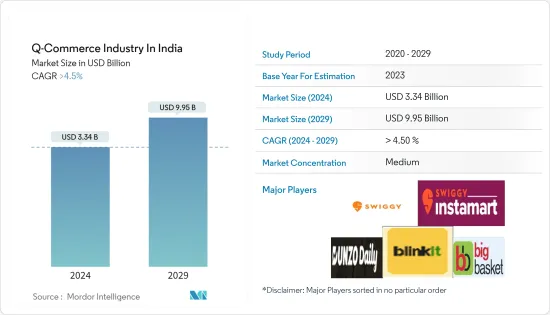PUBLISHER: Mordor Intelligence | PRODUCT CODE: 1537706

PUBLISHER: Mordor Intelligence | PRODUCT CODE: 1537706
Q-Commerce Industry In India - Market Share Analysis, Industry Trends & Statistics, Growth Forecasts (2024 - 2029)
The Q-Commerce Industry In India Market size is estimated at USD 3.34 billion in 2024, and is expected to reach USD 9.95 billion by 2029, growing at a CAGR of greater than 4.5% during the forecast period (2024-2029).

In India, the quick commerce market is witnessing a significant growth rate because it provides consumers faster shopping experience than any other e-commerce platform. The reason for the increased adoption of quick commerce platforms is because of the fast and convenient delivery service. The rising urbanization and the trend of online shopping also contribute to the growth of the quick commerce industry in India.
Key Highlights
- During the COVID-19 pandemic, quick commerce experienced tremendous growth and became a part of people's busy lifestyles. After the pandemic, the market is still experiencing increased demand in food and retail segments due to convenient on-demand delivery and digital offerings.
- Many brands like Roofers, Zepto, Zomato, Swiggy, Big Basket, etc., grew by integrating quick commerce as a part of the business.
- There has been an increased purchasing rate in metro and Tier I cities in India because of the fastest delivery of groceries and other products, driving the quick commerce market in the country.
- Since the market is growing gradually, companies are using geographical mapping technologies to open dark stores (a type of delivery model for quick commerce), which helps in delivering more than 60% of orders in 40 minutes.
Initiatives like these by the players in the market boost the growth rate of the quick commerce market in India.
India Quick Commerce Market Trends
Rising Entry of Startups into the Market
- The adoption of quick commerce platforms in India is increasing to meet the needs of consumers for fast delivery of products within 10-30 minutes.
Growing Need for Instant Delivery Driving the Market
India Quick Commerce Industry Overview
Additional Benefits:
TABLE OF CONTENTS
1 INTRODUCTION
- 1.1 Study Deliverables
- 1.2 Study Assumptions
- 1.3 Scope of the Study
2 RESEARCH METHODOLOGY
3 EXECUTIVE SUMMARY
4 MARKET DYNAMICS
- 4.1 Market Overview
- 4.2 Market Drivers
- 4.2.1 Faster Buying Process Drives the Market
5 MARKET SEGMENTATION
6 COMPETITIVE LANDSCAPE
7 MARKET FUTURE TRENDS
8 DISCLAIMER AND ABOUT US




